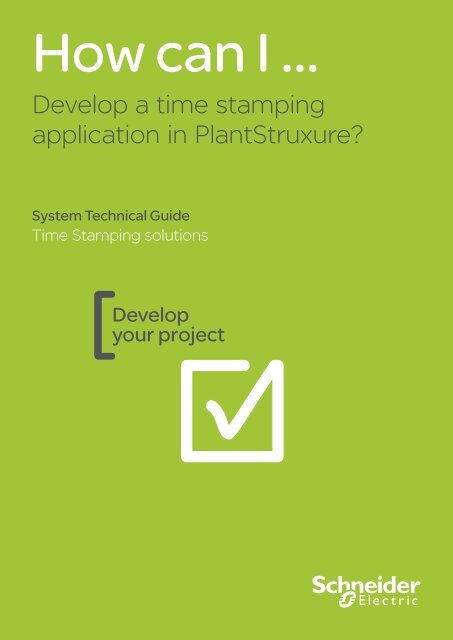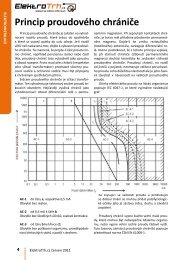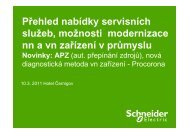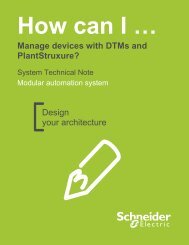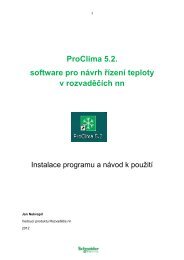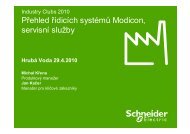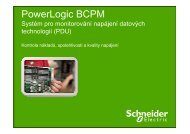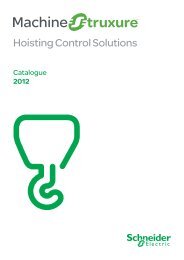Develop a time stamping application in PlantStruxure? - Schneider ...
Develop a time stamping application in PlantStruxure? - Schneider ...
Develop a time stamping application in PlantStruxure? - Schneider ...
Create successful ePaper yourself
Turn your PDF publications into a flip-book with our unique Google optimized e-Paper software.
How can I …<br />
<strong>Develop</strong> a <strong>time</strong> <strong>stamp<strong>in</strong>g</strong><br />
<strong>application</strong> <strong>in</strong> <strong>PlantStruxure</strong><br />
System Technical Guide<br />
Time Stamp<strong>in</strong>g solutions<br />
<strong>Develop</strong><br />
your project
Disclaimer<br />
This document is not comprehensive for any systems us<strong>in</strong>g the given architecture<br />
and does not absolve users of their duty to uphold the safety requirements for the<br />
equipment used <strong>in</strong> their systems or compliance with both national or <strong>in</strong>ternational<br />
safety laws and regulations.<br />
It is assumed that readers already know how to use the products described <strong>in</strong> this<br />
document.<br />
This document does not replace any specific product documentation.<br />
3
The STG Collection<br />
System Technical Guides (STG) are designed to help project eng<strong>in</strong>eers and Alliance<br />
System Integrators dur<strong>in</strong>g the development of a project. The STGs support users<br />
dur<strong>in</strong>g the architecture selection and the project execution (design, configuration,<br />
implementation and operation) phases with an <strong>in</strong>troduction to the system operat<strong>in</strong>g<br />
modes.<br />
Each STG is a starter kit that provides users with:<br />
• Technical documentation<br />
• Application examples<br />
• Object libraries<br />
Each STG addresses one or several customer challenges with<strong>in</strong> the proposed<br />
solution us<strong>in</strong>g the offer from <strong>Schneider</strong> Electric.<br />
All explanations and <strong>application</strong>s have been developed by both <strong>Schneider</strong> Electric<br />
experts and system <strong>in</strong>tegrators <strong>in</strong> our solution labs. The contributions from the system<br />
<strong>in</strong>tegrators help the kit’s content meet the expectations of our users.<br />
All STGs are illustrated with <strong>in</strong>dustry-specific <strong>application</strong>s to give more concrete<br />
examples of the methodology.<br />
STGs are not <strong>in</strong>tended to be used as substitutes for the technical documentation<br />
related to the <strong>in</strong>dividual components, but rather to complement these materials and<br />
tra<strong>in</strong><strong>in</strong>g.<br />
<strong>Develop</strong>ment Environment<br />
Each STG has been developed <strong>in</strong> one of our solution platform labs us<strong>in</strong>g a typical<br />
<strong>PlantStruxure</strong> architecture.<br />
<strong>PlantStruxure</strong>, the Process Automation System from <strong>Schneider</strong> Electric, is a<br />
collaborative system that allows <strong>in</strong>dustrial and <strong>in</strong>frastructure companies to meet their<br />
automation needs while also address<strong>in</strong>g grow<strong>in</strong>g energy management requirements.<br />
With<strong>in</strong> a s<strong>in</strong>gle environment, measured energy and process data can be analyzed to<br />
help build an optimized plant.<br />
4
Table of Contents<br />
Quick Start Guide .....................................................................7<br />
1. Introduction...........................................................................9<br />
1.1. Purpose ........................................................................................................................................................ 9<br />
1.2. Introduction to <strong>time</strong> <strong>stamp<strong>in</strong>g</strong> ...................................................................................................................... 9<br />
1.3. Challenges.................................................................................................................................................. 12<br />
1.4. Prerequisites .............................................................................................................................................. 12<br />
1.5. Methodology............................................................................................................................................... 12<br />
1.6. Limitation................................................................................................................................................... 13<br />
2. Selection..............................................................................15<br />
2.1. Selection criteria ........................................................................................................................................ 15<br />
2.2. Selection steps............................................................................................................................................ 15<br />
2.3. Solution list ................................................................................................................................................ 17<br />
3. Design..................................................................................21<br />
3.1. System hardware design............................................................................................................................. 21<br />
3.2. System software design .............................................................................................................................. 23<br />
3.3. DFB design ................................................................................................................................................ 24<br />
3.4. SCADA design............................................................................................................................................ 37<br />
4. Configuration......................................................................41<br />
4.1. Time stamped by module............................................................................................................................ 41<br />
4.2. Time stamped by program.......................................................................................................................... 44<br />
5. Implementation...................................................................47<br />
5.1. PAC............................................................................................................................................................ 47<br />
5.2. SCADA ....................................................................................................................................................... 50<br />
5
6. Operation.............................................................................53<br />
6.1 Time <strong>stamp<strong>in</strong>g</strong> diagnostics.......................................................................................................................... 53<br />
6.2 Time <strong>stamp<strong>in</strong>g</strong> alarms................................................................................................................................. 54<br />
7. Hydro power plant example ..............................................55<br />
7.1. Introduction to the hydro power plant process .......................................................................................... 55<br />
7.2. Application background............................................................................................................................. 56<br />
7.3. System architecture .................................................................................................................................... 57<br />
7.4. PAC <strong>application</strong>......................................................................................................................................... 58<br />
7.5. SCADA <strong>application</strong> .................................................................................................................................... 60<br />
7.7. Device list................................................................................................................................................... 63<br />
Appendix .................................................................................65<br />
Abbreviations .................................................................................................................................................... 65<br />
6
Quick Start Guide<br />
Quick Start Guide<br />
The goal of this System Technical Guide (STG) is to provide recommendations,<br />
guidel<strong>in</strong>es, and examples to help develop a <strong>time</strong> <strong>stamp<strong>in</strong>g</strong> solution effectively and<br />
reliably for a typical <strong>PlantStruxure</strong> architecture.<br />
To get the most out of this STG, please consider the follow<strong>in</strong>g suggestions::<br />
- If this is the first <strong>time</strong> you are us<strong>in</strong>g the <strong>time</strong> <strong>stamp<strong>in</strong>g</strong> <strong>application</strong>, we recommend<br />
that you read the entire STG before proceed<strong>in</strong>g.<br />
- If you are already familiar with <strong>time</strong> <strong>stamp<strong>in</strong>g</strong> technology and want to def<strong>in</strong>e a<br />
solution for your <strong>application</strong>, you can start at Chapter 2.<br />
- If your solution architecture is def<strong>in</strong>ed and you want to setup your <strong>application</strong>, you<br />
can start at Chapter 3.<br />
- If you already have knowledge about implement<strong>in</strong>g <strong>time</strong> <strong>stamp<strong>in</strong>g</strong> <strong>application</strong>s<br />
with <strong>Schneider</strong> products and you want to see some real examples, please go to<br />
Chapter 7 of this STG.<br />
7
1-Introduction<br />
8
1-Introduction<br />
1. Introduction<br />
1.1. Purpose<br />
With cont<strong>in</strong>uous developments <strong>in</strong> <strong>in</strong>dustry and technology, more and more<br />
automation systems are be<strong>in</strong>g implemented <strong>in</strong> different fields. For better control and<br />
ma<strong>in</strong>tenance of complex systems, end users of these automation systems require<br />
process<strong>in</strong>g data with <strong>time</strong> stamps.<br />
This guide proposes a method to implement a <strong>time</strong> <strong>stamp<strong>in</strong>g</strong> solution us<strong>in</strong>g a<br />
Programmable Automation Controller (PAC) and a SCADA system. Moreover, this<br />
STG suggests the best practices to follow to take advantage of system openness<br />
while reduc<strong>in</strong>g the risks of misuse and misunderstand<strong>in</strong>gs.<br />
The recommendations and guidel<strong>in</strong>es provided <strong>in</strong> the follow<strong>in</strong>g chapters are generic<br />
and targeted at <strong>time</strong> <strong>stamp<strong>in</strong>g</strong> <strong>application</strong>s such as track<strong>in</strong>g a sequence of events<br />
(SOE) or <strong>time</strong> <strong>stamp<strong>in</strong>g</strong> alarms. However, we use the specific example of a sequence<br />
of events (SOE) function <strong>in</strong> a hydro power plant to illustrate a <strong>time</strong> <strong>stamp<strong>in</strong>g</strong><br />
<strong>application</strong> <strong>in</strong> a process control system.<br />
1.2. Introduction to <strong>time</strong> <strong>stamp<strong>in</strong>g</strong><br />
1.2.1 What is <strong>time</strong> <strong>stamp<strong>in</strong>g</strong><br />
A <strong>time</strong> stamp <strong>in</strong> an automation system is the <strong>time</strong> <strong>in</strong>formation of when a signal event<br />
occurred. It is recorded by the control units <strong>in</strong> a consistent format. The function of<br />
record<strong>in</strong>g the <strong>time</strong> stamps is called <strong>time</strong> <strong>stamp<strong>in</strong>g</strong>.<br />
Time <strong>stamp<strong>in</strong>g</strong> is an important function for track<strong>in</strong>g processes <strong>in</strong> some automation<br />
systems, such as hydro power plant control and oil pipel<strong>in</strong>e control. This function<br />
provides operators with a method to better identify process sequences <strong>in</strong> a large and<br />
complex system, to f<strong>in</strong>e tune protection and control schemes, and improve overall<br />
system reliability. One of the most important <strong>application</strong>s of <strong>time</strong> <strong>stamp<strong>in</strong>g</strong> is to help<br />
track down the root causes after a system error is detected.<br />
1.2.2 What is the process flow of the <strong>time</strong> <strong>stamp<strong>in</strong>g</strong> function<br />
The <strong>time</strong> <strong>stamp<strong>in</strong>g</strong> function <strong>in</strong> a process automation system can be implemented <strong>in</strong><br />
three steps: <strong>time</strong> sourc<strong>in</strong>g, <strong>stamp<strong>in</strong>g</strong> <strong>time</strong> on the event data, and monitor<strong>in</strong>g & <strong>in</strong>quiry.<br />
The follow<strong>in</strong>g flow chart shows the <strong>time</strong> <strong>stamp<strong>in</strong>g</strong> process:<br />
9
1-Introduction<br />
Figure 1 Time <strong>stamp<strong>in</strong>g</strong> process<br />
Time synchronization – A process that uses a clock reference to synchronize the<br />
<strong>time</strong> used for <strong>stamp<strong>in</strong>g</strong>.<br />
A standalone source with a regulated <strong>time</strong> provides the clock reference used to<br />
synchronize the <strong>time</strong> clock for <strong>stamp<strong>in</strong>g</strong>.<br />
There are three different types of clock references that can be used <strong>in</strong> <strong>Schneider</strong><br />
Electric Programmable Automation Controller (PAC) systems:<br />
• PC <strong>time</strong><br />
• Network Time Protocol (NTP) server <strong>time</strong><br />
• DCF77 signal <strong>time</strong><br />
The <strong>time</strong> clock used for <strong>stamp<strong>in</strong>g</strong> is the <strong>in</strong>ternal clock which is typically located <strong>in</strong><br />
PAC modules or <strong>time</strong> servers. They can be synchronized with an appropriate clock<br />
reference depend<strong>in</strong>g on <strong>application</strong> needs. Generally, there are three types of <strong>time</strong><br />
clocks that can be used <strong>in</strong> a PAC system:<br />
• Real Time Clock (RTC) which is <strong>in</strong> the CPU<br />
• Network Time Protocol (NTP) server clock<br />
• ERT clock<br />
The next table shows the way the <strong>time</strong> clock is synchronized with the clock reference.<br />
10
1-Introduction<br />
Table 1 Synchronization between the clock reference and <strong>time</strong> clock<br />
Time stamps on the event data – performs the <strong>time</strong> <strong>stamp<strong>in</strong>g</strong> function.<br />
The PAC system records the <strong>time</strong> data with the <strong>time</strong> clock when the event occurs and<br />
associates the <strong>time</strong> <strong>in</strong>formation with the event signal data.<br />
Monitor<strong>in</strong>g & data <strong>in</strong>quiry – manages the <strong>time</strong> stamped data.<br />
The <strong>time</strong> stamped data is displayed and recorded on the SCADA system. The <strong>time</strong><br />
stamped data can be used <strong>in</strong> different <strong>application</strong>s such as sequence of events (SOE)<br />
and alarm signals. The data history helps the user to analyze the event sequence.<br />
1.2.3 Benefits of a <strong>time</strong> <strong>stamp<strong>in</strong>g</strong> <strong>application</strong><br />
Time <strong>stamp<strong>in</strong>g</strong> <strong>in</strong> automation systems helps with process control and ma<strong>in</strong>tenance by<br />
add<strong>in</strong>g a <strong>time</strong>stamp to every event.<br />
In a complex automation system, many events can cause the system to error and<br />
stop the system. Because of the mass of <strong>in</strong>formation the system provides when<br />
stopp<strong>in</strong>g, f<strong>in</strong>d<strong>in</strong>g useful <strong>in</strong>formation can be tricky. Time <strong>stamp<strong>in</strong>g</strong> provides a way of<br />
order<strong>in</strong>g the <strong>in</strong>formation with <strong>time</strong> stamps mak<strong>in</strong>g it simpler to track errors..<br />
For example, suppose four discrete events -A, B, C, and D as shown <strong>in</strong> Figure 2<br />
impact on each other. A detected error <strong>in</strong> one of the events can trigger a cha<strong>in</strong><br />
reaction prevent<strong>in</strong>g the other three from runn<strong>in</strong>g successfully and result<strong>in</strong>g <strong>in</strong> an<br />
emergency stop.<br />
If there are no <strong>time</strong> stamps on the event records, it becomes very difficult to say<br />
which of the events caused the stop.<br />
With the <strong>time</strong> <strong>stamp<strong>in</strong>g</strong> function, the events are sequentially recorded with <strong>time</strong><br />
<strong>in</strong>formation, enabl<strong>in</strong>g quicker and easier ma<strong>in</strong>tenance as the user can see which of<br />
the events started the cha<strong>in</strong> reaction that caused the system to stop.<br />
This is the benefit of the <strong>time</strong> <strong>stamp<strong>in</strong>g</strong> function <strong>in</strong> a complex system.<br />
11
1-Introduction<br />
1.3. Challenges<br />
Figure 2 Event sequence analysis with and without <strong>time</strong> <strong>stamp<strong>in</strong>g</strong> function<br />
This STG uses a hydro power plant (HPP) automation process system as an example<br />
to illustrate the <strong>application</strong> of <strong>time</strong> <strong>stamp<strong>in</strong>g</strong>. The HPP system is detailed <strong>in</strong> Chapter 7.<br />
For customers <strong>in</strong> <strong>in</strong>dustries that require the <strong>time</strong> <strong>stamp<strong>in</strong>g</strong> <strong>application</strong> mentioned<br />
above, the challenges are:<br />
• Time synchronization<br />
• Time resolution<br />
• Time accuracy<br />
• Implementation <strong>in</strong> a large scale system<br />
1.4. Prerequisites<br />
<strong>Schneider</strong> Electric recommends that the user have knowledge of the follow<strong>in</strong>g<br />
systems:<br />
• <strong>Schneider</strong> Electric PACs – Quantum, Premium and M340.<br />
• <strong>Schneider</strong> Electric software - UnityPro, Vijeo Citect and OPC Factory Server<br />
1.5. Methodology<br />
This STG expla<strong>in</strong>s the project methodology and <strong>in</strong>cludes the follow<strong>in</strong>g phases:<br />
Selection, Design, Configuration, Implementation and Operation. A step-by-step<br />
12
1-Introduction<br />
methodology is provided to create a <strong>time</strong> <strong>stamp<strong>in</strong>g</strong> <strong>application</strong>. Here is an overview of<br />
this method:<br />
• Selection: In this phase, you will decide the selection criteria and steps that will<br />
guide you to select the most appropriate solution for your <strong>application</strong><br />
requirements.<br />
• Design: This phase comprises four ma<strong>in</strong> parts:<br />
• System hardware design: how to develop the <strong>time</strong> <strong>stamp<strong>in</strong>g</strong> system<br />
hardware.<br />
• System software design: how to develop <strong>time</strong> <strong>stamp<strong>in</strong>g</strong> with <strong>Schneider</strong><br />
Electric software.<br />
• Derived Function Block (DFB) design: provide a package of the DFBs for<br />
the <strong>time</strong> <strong>stamp<strong>in</strong>g</strong> <strong>application</strong>.<br />
• SCADA design: how to develop Vijeo Citect <strong>time</strong> <strong>stamp<strong>in</strong>g</strong> genies.<br />
• Configuration: This phase expla<strong>in</strong>s how to set up the <strong>time</strong> <strong>stamp<strong>in</strong>g</strong> <strong>application</strong>:<br />
• How to set up <strong>time</strong> clock synchronization with references<br />
• How to set up a <strong>time</strong> <strong>stamp<strong>in</strong>g</strong> solution by module<br />
• How to set up a <strong>time</strong> <strong>stamp<strong>in</strong>g</strong> solution by program<br />
• Implementation: This phase expla<strong>in</strong>s the programm<strong>in</strong>g requirements:<br />
• The PAC part expla<strong>in</strong>s how to set up the <strong>time</strong> <strong>stamp<strong>in</strong>g</strong> sections.<br />
• The SCADA part expla<strong>in</strong>s how to set up the Vijeo Citect <strong>time</strong> <strong>stamp<strong>in</strong>g</strong><br />
genies and alarms.<br />
• Operation: This phase presents the capabilities of the f<strong>in</strong>al SCADA <strong>application</strong>:<br />
• How to use Vijeo Citect <strong>time</strong> <strong>stamp<strong>in</strong>g</strong> genies<br />
• How to use the <strong>time</strong> <strong>stamp<strong>in</strong>g</strong> alarms<br />
1.6. Limitation<br />
The accuracy of <strong>time</strong>stamps relies on the accuracy of the clock reference. It is also<br />
impacted by the transmission mode. For example, when the CPU RTC gets the <strong>time</strong><br />
from the NTP server, the <strong>time</strong> is delayed by the transmission through the network. A<br />
method must be developed to calculate the delay and adjust the clock reference as<br />
needed. This is not <strong>in</strong> the scope of this STG. For the Purposes of this guide, we<br />
assume that the <strong>time</strong> used for <strong>time</strong> <strong>stamp<strong>in</strong>g</strong> does not suffer any delay.<br />
13
2-Selection<br />
14
2-Selection<br />
2. Selection<br />
2.1. Selection criteria<br />
This chapter describes the selection of the components needed to build a <strong>time</strong><br />
<strong>stamp<strong>in</strong>g</strong> <strong>application</strong> and provides a solution list.<br />
Each automation control project has specific requirements and constra<strong>in</strong>ts, such as<br />
the size of the plant, control complexity, and project budget. The <strong>time</strong> <strong>stamp<strong>in</strong>g</strong><br />
resolution is a very important requirement of the project. The requirements and<br />
constra<strong>in</strong>ts def<strong>in</strong>ed <strong>in</strong> the project specification are used as guidel<strong>in</strong>es to select the<br />
<strong>time</strong> <strong>stamp<strong>in</strong>g</strong> solution. There are three criteria for the <strong>time</strong> <strong>stamp<strong>in</strong>g</strong> <strong>application</strong><br />
selection:<br />
• Time resolution<br />
• System scale (complexity)<br />
• Cost<br />
2.2. Selection steps<br />
Accord<strong>in</strong>g to the selection criteria, the <strong>time</strong> <strong>stamp<strong>in</strong>g</strong> solution is developed <strong>in</strong> four<br />
steps:<br />
• Select<strong>in</strong>g a <strong>time</strong> <strong>stamp<strong>in</strong>g</strong> method and mode<br />
• Select<strong>in</strong>g a PAC platform<br />
• Select<strong>in</strong>g an I/O architecture<br />
• Select<strong>in</strong>g a CPU task mode<br />
2.2.1. Select<strong>in</strong>g a <strong>time</strong> <strong>stamp<strong>in</strong>g</strong> method and mode<br />
Two different <strong>time</strong> <strong>stamp<strong>in</strong>g</strong> methods can be used, <strong>time</strong> stamped by module or <strong>time</strong><br />
stamped by program.<br />
15
2-Selection<br />
Figure 3 Time <strong>stamp<strong>in</strong>g</strong> methods and modes<br />
• Time stamped by module is a <strong>time</strong> <strong>stamp<strong>in</strong>g</strong> method us<strong>in</strong>g a Quantum expert<br />
<strong>time</strong> stamped module – 140 ERT 854 10. With this method, the ERT mode is<br />
used.<br />
In ERT mode, the events are stamped by the ERT clock <strong>in</strong> the ERT module and<br />
sent to the PAC dur<strong>in</strong>g system scan. The PAC only needs to reformat the <strong>time</strong><br />
stamps for the SCADA system.<br />
• Time stamped by program is a <strong>time</strong> <strong>stamp<strong>in</strong>g</strong> method performed by the<br />
<strong>application</strong> program. With this method, two modes of <strong>time</strong> synchronization can<br />
be used:<br />
• RTC mode, the <strong>time</strong> stamps are made with the CPU Real Time Clock. The<br />
RTC is updated by PC <strong>time</strong> or NTP server <strong>time</strong>. The <strong>in</strong>put signal is obta<strong>in</strong>ed<br />
by a discrete or expert <strong>in</strong>put module. The PAC system comb<strong>in</strong>es the RTC<br />
and <strong>in</strong>put data to produce the <strong>time</strong>stamped data <strong>in</strong> a format that can be<br />
accepted by the SCADA system.<br />
• NTP mode, the <strong>time</strong> stamps are made with the NTP server clock. The <strong>in</strong>put<br />
signal is obta<strong>in</strong>ed by a discrete or expert <strong>in</strong>put module. The PAC system<br />
comb<strong>in</strong>es the NTP server clock and <strong>in</strong>put data to produce <strong>time</strong> stamped<br />
data <strong>in</strong> a format that can be accepted by the SCADA system.<br />
2.2.2. Select PAC platform<br />
There are three PAC platforms that can be selected: Quantum, Premium and M340;<br />
however, only the Quantum CPU supports the ERT module. Thus, the <strong>time</strong> stamped<br />
by module method can only be implemented on a Quantum system.<br />
16
2-Selection<br />
2.2.3. Select I/O architecture<br />
Three I/O architectures can be selected: local I/O, remote I/O and distributed I/O.<br />
Systems with local I/O can achieve high resolution <strong>time</strong> stamps. For remote I/O and<br />
distributed I/O, the <strong>time</strong> stamp resolution is limited by the PAC MAST task scan cycle.<br />
I/O architecture depends on the PAC platform. The follow<strong>in</strong>g table shows the I/O<br />
architectures for different PAC platforms.<br />
Table 2 Supported I/O architecture on each PAC platform<br />
Note: The local I/O architecture is not fully supported by Quantum hot standby.<br />
2.2.4. Select CPU task mode<br />
2.3. Solution list<br />
Three task modes can be selected: MAST, FAST and EVENT task modes. Only the<br />
local I/O architecture supports the FAST and EVENT tasks. If users select the remote<br />
I/O or distributed I/O, then the FAST task and EVENT task modes are not available,<br />
and the <strong>time</strong> stamp resolution is lower.<br />
Note:<br />
1. The EVENT task is only supported by the Quantum platform. The expert module<br />
reference is 140 HLI 340 00.<br />
2. Task mode is not considered <strong>in</strong> the <strong>time</strong> stamped by module method. In this case,<br />
the <strong>time</strong> <strong>stamp<strong>in</strong>g</strong> is dealt with <strong>in</strong> module and not <strong>in</strong> program. The task mode is only<br />
available <strong>in</strong> the program, not the module.<br />
Accord<strong>in</strong>g to the selection procedure, a number of solutions us<strong>in</strong>g <strong>Schneider</strong><br />
Electric’s <strong>PlantStruxure</strong> products are provided to help the user make a decision based<br />
on the <strong>application</strong> requirements. The follow<strong>in</strong>g list presents the most representative<br />
solutions for <strong>time</strong> <strong>stamp<strong>in</strong>g</strong> <strong>application</strong>s.<br />
17
2-Selection<br />
Table 3 Solution list for <strong>time</strong> <strong>stamp<strong>in</strong>g</strong> function<br />
Table 3 notes:<br />
1. The <strong>time</strong> stamped resolution can be evaluated with the task scan <strong>time</strong>. Take<br />
solution #3 for example, if the PAC FAST task scan <strong>time</strong> is set to 1 ms, the <strong>time</strong><br />
<strong>stamp<strong>in</strong>g</strong> resolution is 1 ms.<br />
2. The <strong>time</strong> stamped resolution can be evaluated with the task scan <strong>time</strong> plus the<br />
translation delay of NTP server clock. Take solution # 8 for example, if the PAC FAST<br />
task scan <strong>time</strong> is set to 1 ms and the NTP clock delay <strong>time</strong> is 10 ms, the <strong>time</strong><br />
<strong>stamp<strong>in</strong>g</strong> resolution is 11 ms.<br />
3. Scale means the complexity of the system.<br />
• Small system - Less than 250 I/O po<strong>in</strong>ts<br />
• Medium system - More than 250 but less than 1000 I/O po<strong>in</strong>ts<br />
• Large system – More than 1000 I/O po<strong>in</strong>ts<br />
Based on the Table 3 solution list, two typical solutions are selected for further<br />
exploration:<br />
Solution #2. The system is built on the Quantum platform us<strong>in</strong>g the method of <strong>time</strong><br />
stamped by module. It can meet the requirements of a large system with high <strong>time</strong><br />
stamp resolution.<br />
Solution #8. The system is built on the M340 platform us<strong>in</strong>g the method of <strong>time</strong><br />
stamped by program. It is economical and suitable for medium and small systems<br />
that do not have critical requirements for the <strong>time</strong> stamp resolution.<br />
18
2-Selection<br />
These two solutions are the ones used <strong>in</strong> the Design, Configuration, Implementation,<br />
and Operation chapters.<br />
19
3-Design<br />
20
3-Design<br />
3. Design<br />
This chapter presents system hardware, system software, DFBs, and SCADA design<br />
that can help the user build a <strong>time</strong> <strong>stamp<strong>in</strong>g</strong> <strong>application</strong>.<br />
3.1. System hardware design<br />
There are two k<strong>in</strong>ds of <strong>time</strong> <strong>stamp<strong>in</strong>g</strong> hardware designs, depend<strong>in</strong>g on whether the<br />
user chooses the <strong>time</strong> stamped by module method or the <strong>time</strong> stamped by program<br />
method.<br />
• Time stamped by module<br />
This solution is designed for a Quantum system to implement the function of <strong>time</strong><br />
<strong>stamp<strong>in</strong>g</strong> by ERT module. The clock reference is <strong>in</strong> DCF77 format, provided by a<br />
GPS receiver. The signal data is automatically <strong>time</strong> stamped by the ERT.. A 1 ms<br />
<strong>time</strong> stamp resolution can be obta<strong>in</strong>ed <strong>in</strong> this <strong>application</strong>.<br />
As shown <strong>in</strong> Figure 5, the system <strong>in</strong>cludes the follow<strong>in</strong>g parts:<br />
• Modicon Quantum Hot Standby system (140 CPU 671 60) with remote I/O<br />
module<br />
• Time <strong>stamp<strong>in</strong>g</strong> module (140 ERT 854 10)<br />
• NTP client module (140 NOE 771 11)<br />
• GPS (Global Position<strong>in</strong>g System) receiver, <strong>in</strong>clud<strong>in</strong>g NTP server unit and<br />
DCF77 unit<br />
Note: NTP server unit provides a clock reference to synchronize the PC <strong>time</strong> with the<br />
PAC system <strong>time</strong>.<br />
21
3-Design<br />
Figure 4 System architecture for “<strong>time</strong> stamped by module”<br />
• Time stamped by program<br />
There are two ways to implement the method of <strong>time</strong> stamped by program. Here we<br />
use the example of NTP mode. The solution is designed based on the M340 system.<br />
The clock reference is provided by the NTP server, and the signal data is <strong>time</strong><br />
stamped by a CPU program.<br />
As showed <strong>in</strong> Fig 6, the system <strong>in</strong>cludes the follow<strong>in</strong>g parts:<br />
• M340 system (BMX P34 2020) with I/O module,<br />
• NTP client module (BMX NOE 0100)<br />
• GPS (Global Position<strong>in</strong>g System) receiver, <strong>in</strong>clud<strong>in</strong>g NTP server unit<br />
22
3-Design<br />
The GPS receiver with NTP server provides the <strong>time</strong> signal to each client by Ethernet.<br />
The CPU obta<strong>in</strong>s the <strong>time</strong> <strong>in</strong>formation through the NTP client module <strong>in</strong> M340 system.<br />
Time stamps with 5-10 ms resolution can be achieved by NTP mode.<br />
GPS Receiver<br />
Human Mach<strong>in</strong>e Interface(HMI)<br />
NTP<br />
Server<br />
Ethernet TCP/IP<br />
NTP synchroniz<strong>in</strong>g<br />
Ethernet Switch<br />
M340 PLC<br />
BMX XBP 0600<br />
CPS<br />
CPU<br />
NOE<br />
DDI_1<br />
CPS2000<br />
DC24V<br />
P34 2020<br />
Modbus, Ethernet<br />
NOE 0100.2<br />
DDI 1602<br />
Signal source<br />
Figure 5 System architecture for “<strong>time</strong> stamped by program” (NTP mode)<br />
3.2. System software design<br />
The software used <strong>in</strong> this STG are based on SoCollaborative, which is a part of<br />
<strong>PlantStruxure</strong>.<br />
Three SoCollaborative software components are needed <strong>in</strong> the design of the <strong>time</strong><br />
<strong>stamp<strong>in</strong>g</strong> function:<br />
• Vijeo Citect<br />
• OFC Factory Server<br />
• Unity Pro<br />
In the Process Operator’s Station:<br />
Vijeo Citect Run Time is used to display the <strong>time</strong> <strong>stamp<strong>in</strong>g</strong> value.<br />
OPC Factory Server is used to connect to the PAC system.<br />
23
3-Design<br />
In the Process Eng<strong>in</strong>eer<strong>in</strong>g Station:<br />
Vijeo Citect configuration is used to design the <strong>time</strong> <strong>stamp<strong>in</strong>g</strong> monitor<strong>in</strong>g system.<br />
OPC Factory Server configuration is used to set up the communication between the<br />
Vijeo Citect (SCADA) and the PAC.<br />
Unity Pro is used to design the PAC system.<br />
Figure 6 shows the data exchange method among the three SoCollaborative software<br />
components.<br />
Figure 6 Data exchange among the SoCollaborative software components<br />
3.3. DFB design<br />
To help the users set up the <strong>time</strong> <strong>stamp<strong>in</strong>g</strong> program easily with Unity PACs (Quantum,<br />
Premium, M340), five DFBs are designed for the <strong>time</strong> <strong>stamp<strong>in</strong>g</strong> solution.<br />
• TS_RTC<br />
• TS_NTP<br />
24
3-Design<br />
• TS_ERT<br />
• TS_DataBase<br />
• TS_DataBase_To_VJC<br />
These DFBs can be applied to the different solutions mentioned <strong>in</strong> Chapter 2. The<br />
def<strong>in</strong>ition of the DFB function and data type are expla<strong>in</strong>ed further on. The overall<br />
function list of the DFB package is shown <strong>in</strong> Table.4.<br />
Table 4 DFB list for <strong>time</strong> <strong>stamp<strong>in</strong>g</strong> function<br />
25
3-Design<br />
Figure 7 shows the program architecture for <strong>time</strong> <strong>stamp<strong>in</strong>g</strong><br />
Figure 7 Program architecture of the <strong>time</strong> <strong>stamp<strong>in</strong>g</strong> function<br />
Time <strong>stamp<strong>in</strong>g</strong> by program handles all of the data process<strong>in</strong>g compared to the <strong>time</strong><br />
<strong>stamp<strong>in</strong>g</strong> by module method, which only handles the data acquisition and<br />
reformatt<strong>in</strong>g from the ERT module.<br />
26
3-Design<br />
DFB1: TS_RTC<br />
Function:<br />
The TS_RTC DFB is designed for <strong>time</strong> <strong>stamp<strong>in</strong>g</strong> with the RTC mode. It adds the <strong>time</strong><br />
stamp to the event data with RTC <strong>time</strong>, and sends out the <strong>time</strong> stamps. With this<br />
function block, the users choose the detection mode for <strong>time</strong> stamps. This DFB also<br />
handles a buffer of up to 100 records of <strong>time</strong> stamped data.<br />
Data type:<br />
• DFB type: TS_RTC<br />
• DFB <strong>in</strong>put/output types:<br />
27
3-Design<br />
The table below gives parameter def<strong>in</strong>itions:<br />
TS_RTC_DFB<br />
Input<br />
No Parameter Type Comment<br />
1 Input TS_DDT_Input TS_DDT_Input.module (BYTE): <strong>in</strong>puts module number<br />
TS_DDT_Input.<strong>in</strong> (ARRAY[1..16] OF BOOL): 16 discrete <strong>in</strong>puts<br />
2 Mode INT mode=1: TS with <strong>in</strong>put Ris<strong>in</strong>g edge detection<br />
mode=2: TS with <strong>in</strong>put Fall<strong>in</strong>g edge detection<br />
mode=3: TS with both Ris<strong>in</strong>g and Fall<strong>in</strong>g edge detection<br />
3 Ack BOOL Acknowledgement of the new TS<br />
A Ris<strong>in</strong>g edge of Ack can trigger an acknowledgment of one TS.<br />
If Ack is set to 1, a new TS is always acknowledge.<br />
4 Reset BOOL error reset, buffer reset<br />
Output<br />
No Parameter Type Comment<br />
1 RTC_<strong>time</strong> Display_NTPC Display_NTPC.DT_Value: real RTC <strong>time</strong> and data<br />
Display_NTPC.Millisecond: real RTC ms<br />
2 nd_ts BOOL nd_ts=1: New TS <strong>in</strong> the buffer<br />
nd_ts=0: The buffer is empty<br />
3 Ts TS Time <strong>stamp<strong>in</strong>g</strong> struct: TS.<strong>in</strong> (WORD):<br />
D0~D5: the channel number of the discrete <strong>in</strong>put<br />
D6, D7: the mode of the <strong>in</strong>put. (01: Ris<strong>in</strong>g edge, 10: Fall<strong>in</strong>g edge)<br />
D8~12: the module number of the <strong>in</strong>put signal<br />
TS.ms (WORD): ms part of the <strong>time</strong> stamp<br />
TS.hour_m<strong>in</strong> (WORD): hour and m<strong>in</strong>ute part of the <strong>time</strong> stamp<br />
(BCD type)<br />
TS.month_day (WORD): month and day part of the <strong>time</strong> stamp<br />
(BCD type)<br />
TS.year (WORD): year part of the <strong>time</strong> stamp (BCD type)<br />
4 Status WORD The status of the DFB.<br />
The DFB has a TS buffer which can store up to 100 TS data. The<br />
data is stored <strong>in</strong> the buffer until the Ack is set to 1.<br />
D0~D7: Quantity of new TS <strong>in</strong> the DFB buffer<br />
D8: Buffer status<br />
0 = Buffer empty<br />
1 = Buffer overloaded<br />
2 = Buffer not empty or overloaded<br />
28
3-Design<br />
DFB2: TS_NTP<br />
Function:<br />
The TS_NTP DFB is designed for <strong>time</strong> <strong>stamp<strong>in</strong>g</strong> with NTP mode. It adds the <strong>time</strong><br />
stamp to the event data with NTP <strong>time</strong>, and sends out the <strong>time</strong> stamps. With this<br />
function block, the user can choose the detection mode for <strong>time</strong> stamps This DFB<br />
also handles a buffer of up to 100 records of <strong>time</strong> stamped data.<br />
Data type:<br />
• DFB type: TS_NTP<br />
• DFB <strong>in</strong>put/output types:<br />
29
3-Design<br />
The next table gives parameter def<strong>in</strong>itions:<br />
TS_NTP_DFB<br />
Input<br />
No Parameter Type Comment<br />
1 Input TS_DDT_Input TS_DDT_Input.module (BYTE): <strong>in</strong>puts module number<br />
TS_DDT_Input.<strong>in</strong> (ARRAY[1..16] OF BOOL): 16 discrete <strong>in</strong>puts<br />
2 Mode INT mode=1: TS with <strong>in</strong>put Ris<strong>in</strong>g edge detection<br />
mode=2: TS with <strong>in</strong>put Fall<strong>in</strong>g edge detection<br />
mode=3: TS with both Ris<strong>in</strong>g and Fall<strong>in</strong>g edge detection<br />
3 Ack BOOL Acknowledgement of the new TS<br />
A Ris<strong>in</strong>g edge of Ack can trigger an acknowledgment of one TS.<br />
If Ack is set to 1, a new TS is always acknowledge.<br />
4 Reset BOOL error reset, buffer reset<br />
Output<br />
No Parameter Type Comment<br />
1 NTP_<strong>time</strong> Display_NTPC Display_NTPC.DT_Value: real RTC <strong>time</strong> and data<br />
Display_NTPC.Millisecond: real RTC ms<br />
2 nd_ts BOOL nd_ts=1: New TS <strong>in</strong> the buffer<br />
nd_ts=0: The buffer is empty<br />
3 Ts TS Time <strong>stamp<strong>in</strong>g</strong> struct: TS.<strong>in</strong> (WORD):<br />
D0~D5: the channel number of the discrete <strong>in</strong>put<br />
D6, D7: the mode of the <strong>in</strong>put. (01: Ris<strong>in</strong>g edge, 10: Fall<strong>in</strong>g edge.)<br />
D8~12: the module number of the <strong>in</strong>put signal.<br />
TS.ms (WORD): ms part of the <strong>time</strong> stamp<br />
TS.hour_m<strong>in</strong> (WORD): hour and m<strong>in</strong>ute part of the <strong>time</strong> stamp<br />
(BCD type)<br />
TS.month_day (WORD): month and day part of the <strong>time</strong> stamp<br />
(BCD type)<br />
TS.year (WORD): year part of the <strong>time</strong> stamp. (BCD type)<br />
4 Status WORD The status of the DFB.<br />
The DFB has a TS buffer which can store up to 100 TS data. The<br />
data is stored <strong>in</strong> the buffer until the Ack is set to 1.<br />
D0~D7: Quantity of new TS <strong>in</strong> the DFB buffer<br />
D8: Buffer status<br />
0 = Buffer empty<br />
1 = Buffer overloaded<br />
2 = Buffer not empty nor overloaded<br />
30
3-Design<br />
DFB3: TS_ERT<br />
Function:<br />
The TS_ERT DFB is designed for reformatt<strong>in</strong>g ERT mode <strong>time</strong> stamps. It receives<br />
the <strong>time</strong> stamps and transforms the data to a format that can be received by SCADA.<br />
This DFB also handles a buffer that can store up to100 records of <strong>time</strong> stamped data.<br />
Data type:<br />
• DFB type: TS_ERT<br />
• DFB <strong>in</strong>put/output types:<br />
31
3-Design<br />
The follow<strong>in</strong>g table gives parameter def<strong>in</strong>itions:<br />
TS_ERT_DFB<br />
Input<br />
No Parameter Type Comment<br />
1 nd_tt BOOL From the p<strong>in</strong> of the ERT nd_tt. Refer to ERT user manual<br />
2 tt_data ERT_10_Ttag From the p<strong>in</strong> of the ERT tt_data. Refer to ERT user manual<br />
Output<br />
No Parameter Type Comment<br />
1 nd_ts BOOL nd_ts=1: New TS <strong>in</strong> the buffer<br />
nd_ts=0: The buffer empty<br />
2 Ts TS Time <strong>stamp<strong>in</strong>g</strong> struct:<br />
TS.<strong>in</strong> (WORD):<br />
D0~D5: The channel number of the discrete <strong>in</strong>put<br />
D6, D7: The mode of the <strong>in</strong>put. (01: Ris<strong>in</strong>g edge, 10:Fall<strong>in</strong>g edge)<br />
D8~12: The module number of the <strong>in</strong>put signal<br />
TS.ms (WORD): ms part of the <strong>time</strong> stamp<br />
TS.hour_m<strong>in</strong> (WORD): hour and m<strong>in</strong> part of the <strong>time</strong> stamp (BCD type)<br />
TS.month_day (WORD): month and day part of the <strong>time</strong> stamp (BCD type)<br />
TS.year (WORD): year part of the <strong>time</strong> stamp (BCD type)<br />
32
3-Design<br />
DFB4: TS_DataBase<br />
Function:<br />
The TS_DataBase DFB is designed for sav<strong>in</strong>g the <strong>time</strong> stampsed data. It is used <strong>in</strong><br />
different <strong>time</strong> <strong>stamp<strong>in</strong>g</strong> modes and can save up to 100 <strong>time</strong> stamped records <strong>in</strong> the<br />
database.<br />
Data type:<br />
• DFB type: TS_DataBase<br />
• DFB <strong>in</strong>put/output types:<br />
33
3-Design<br />
The follow<strong>in</strong>g table gives parameter def<strong>in</strong>itions:<br />
TS_DataBase<br />
Input<br />
No Parameter Type Comment<br />
1 ND_TS BOOL The new TS is saved <strong>in</strong> the DataBase<br />
2 TS TS Time <strong>stamp<strong>in</strong>g</strong> struct:<br />
TS.<strong>in</strong> (WORD)<br />
D0~D5: The channel number of the discrete <strong>in</strong>put<br />
D6, D7: The mode of the <strong>in</strong>put. (01: Ris<strong>in</strong>g edge, 10: Fall<strong>in</strong>g<br />
edge)<br />
D8~12: The module number of the <strong>in</strong>put signal<br />
TS.ms (WORD): ms part of the <strong>time</strong> stamp<br />
TS.hour_m<strong>in</strong> (WORD): hour and m<strong>in</strong> part of the <strong>time</strong> stamp<br />
(BCD type)<br />
TS.month_day (WORD): month and day part of the <strong>time</strong> stamp<br />
(BCD type)<br />
TS.year (WORD): year part of the <strong>time</strong> stamp (BCD type)<br />
Output<br />
No Parameter Type Comment<br />
1 TS_DB ARRAY[0..99] OF TS Time <strong>stamp<strong>in</strong>g</strong> structure array: The <strong>time</strong> stamps database<br />
The length of the database is 100<br />
2 DB_DPTR UINT It is a po<strong>in</strong>ter <strong>in</strong> the Database that po<strong>in</strong>ts to the TS which is<br />
sent to the Database when the SCADA is ready.<br />
34
3-Design<br />
DFB5: TS_DataBase_To_VJC<br />
Function:<br />
The TS_DataBase_To_VJC DFB is designed to facilitate the communication tags<br />
between the PAC and Vijeo Citect SCADA. It allows the <strong>time</strong> <strong>stamp<strong>in</strong>g</strong> database to<br />
transfer from the PAC to Vijeo Citect <strong>in</strong> the asynchronous mode. It means that the<br />
<strong>time</strong> stamps which are recorded by the TS_DataBase DFB can be transferred to the<br />
Vijeo Citect one at a <strong>time</strong> <strong>in</strong> each communication cycle. It can save the<br />
communication tags between the PAC and the SCADA system.<br />
Data type:<br />
• DFB type: TS_DataBase_To_VJC<br />
• DFB <strong>in</strong>put/output types:<br />
35
3-Design<br />
The follow<strong>in</strong>g table gives parameter def<strong>in</strong>itions:<br />
TS_DataBase_To_VJC<br />
Input<br />
No Parameter Type Comment<br />
1 DB_DPTR UINT It is a po<strong>in</strong>ter <strong>in</strong> the Database that po<strong>in</strong>ts to the TS<br />
which is sent to the Database when the SCADA is<br />
ready.<br />
2 VJC_DPTR UINT It is the po<strong>in</strong>ter to TS that is prepared to be sent to<br />
Vijeo Citect <strong>in</strong> the DataBase. If the VCJ_DPR is<br />
equal to DB_DPTR, it means all the TS <strong>in</strong><br />
database have been transferred to Vijieo Citect<br />
3 TS_DB ARRAY[0..99] OF TS Time <strong>stamp<strong>in</strong>g</strong> structure array: The <strong>time</strong> <strong>stamp<strong>in</strong>g</strong><br />
DataBase<br />
Length of the database is 100<br />
Output<br />
No Parameter Type Comment<br />
1 In WORD Input signal (event data) for <strong>time</strong> stamped<br />
2 Ms WORD ms of the <strong>time</strong> stamp<br />
3 hour_m<strong>in</strong> WORD hour and m<strong>in</strong>ute of the <strong>time</strong> stamp<br />
4 month_day WORD month and day of the <strong>time</strong> stamp<br />
5 Year WORD year of the <strong>time</strong> stamp<br />
6 PAC_DPTR UINT It is the po<strong>in</strong>ter to the TS array that needs to be<br />
sent to Vijeo Citect <strong>in</strong> the DataBase. It is sent to<br />
SCADA to control the communication cycle<br />
between PAC and Vijeo Citect SCADA<br />
36
3-Design<br />
3.4. SCADA design<br />
The Vijeo Citect <strong>time</strong> <strong>stamp<strong>in</strong>g</strong> genies are used to display the digital <strong>in</strong>put signal with<br />
<strong>time</strong> stamps.<br />
Follow<strong>in</strong>g is an example of us<strong>in</strong>g the genies with Vijeo Citect. The genies are named<br />
D_TS with the function named Time<strong>stamp<strong>in</strong>g</strong>_xxx(). The <strong>time</strong> stamps from the PLC<br />
will be displayed on the Vijeo Citect screen.<br />
2<br />
1<br />
1. Add the genies named D_TS <strong>in</strong> the Vijeo Citect screen.<br />
The genies’ parameters <strong>in</strong>clude:<br />
Channel: Vijeo Citect <strong>in</strong>ternal tag, which is used to get the digital channel status<br />
from the PAC.<br />
TimeStamp<strong>in</strong>g: Vijeo Citect <strong>in</strong>ternal tag, which is used to get the digital channel<br />
and <strong>time</strong> <strong>stamp<strong>in</strong>g</strong> from the PAC.<br />
TextOff: customer remark when the channel is OFF<br />
TextOn: customer remark when the channel is ON<br />
2. Add the function named Time<strong>stamp<strong>in</strong>g</strong>_xxx() <strong>in</strong> the Vijeo Citect screen.<br />
Time<strong>stamp<strong>in</strong>g</strong>_xxx( ) function design:<br />
Synchronize the cycle <strong>time</strong> between the PAC and SCADA to get the right <strong>time</strong><br />
stamped data. The user needs to create three functions for each mode: RTC,<br />
NTP and ERT.<br />
37
3-Design<br />
For example, the TimeStamp<strong>in</strong>g_RTC( ) function code is presented below:<br />
38
3-Design<br />
This figure shows the <strong>time</strong> <strong>stamp<strong>in</strong>g</strong> genies <strong>in</strong> the RUN mode.<br />
Channel status Channel status Text<br />
39
3-Design<br />
40
4-Configuration<br />
4. Configuration<br />
This chapter provides configuration methods accord<strong>in</strong>g to the different <strong>time</strong> stamped<br />
solutions.<br />
4.1. Time stamped by module<br />
There are three parts to configure the <strong>time</strong> stamped by module solution: the <strong>time</strong><br />
reference device, PAC and SCADA. This configuration is implemented accord<strong>in</strong>g to<br />
solution #2, refer to Table 3.<br />
• Time reference device - set up GPS receiver<br />
Step<br />
Action<br />
1 Put the GPS receiver module <strong>in</strong>to the BBS-3 GPS, and connect the<br />
antenna.<br />
2 Check if the synchronization is OK.<br />
3 Set up the <strong>time</strong> synchronization module (DCF module).<br />
4 Put the DCF77 module <strong>in</strong>to the BBS-3 GPS and connect it to the ERT<br />
module for <strong>time</strong> synchronization.<br />
41
4-Configuration<br />
• PAC configuration<br />
Step<br />
Action<br />
1 Mount the ERT modules on the Quantum rack.<br />
Note: The extension I/O rack cannot support the ERT module.<br />
2 Set up the ERT module Input and Output Mapp<strong>in</strong>g.<br />
3 Set up the ERT.Module.Clock to DCF/GPS-SYNC.<br />
42
4-Configuration<br />
• SCADA<br />
The example sets up the communication between the PAC and SCADA with OFS<br />
configuration tool.<br />
Step<br />
Action<br />
1 Generate the .XVM file from the UnityPro project.<br />
2 Set up a device named STG_TS <strong>in</strong> the OFS configuration tool.<br />
Import the .XVM file <strong>in</strong>to device symbol file.<br />
3 Set up the SCADA I/O device with the Express I/O Device Setup tool.<br />
Note: Select the OPC protocol as the communication protocol.<br />
4 Set up the OPCAccessPaths <strong>in</strong> the Vijeo Citect.<strong>in</strong>i file. Make sure the value<br />
of the OPCAccessPaths is the same as the name <strong>in</strong> the OFS configuration<br />
tool.<br />
43
4-Configuration<br />
4.2. Time stamped by program<br />
There are three parts to configure for the <strong>time</strong> stamped by program method; the <strong>time</strong><br />
reference device, PAC and SCADA. The example is implemented accord<strong>in</strong>g to<br />
solution #3, refer to Table 3.<br />
• Time reference device<br />
There are two parts to the <strong>time</strong> reference configuration, the GPS receiver setup and<br />
the <strong>time</strong> synchronization setup.<br />
Set up GPS receiver:<br />
Step<br />
Action<br />
1 Put the GPS receiver module <strong>in</strong>to the BBS-3 GPS and connect antenna.<br />
2 Check if the synchronization is correct.<br />
Set up <strong>time</strong> synchronization module (NTP server):<br />
Step<br />
Action<br />
1 Put the NTP server module <strong>in</strong>to the BBS-3 GPS and connect it to the<br />
network for network <strong>time</strong> synchronization.<br />
2 Set up the NTP server.<br />
For example, NTP server IP address is 192.168.0.6<br />
Run the dnts3.exe with the follow<strong>in</strong>g command to set up the NTP server<br />
IP address:<br />
“dnts3 –s 192.168.0.6 255.255.255.0 00-03-b9-a9-0b-9b”<br />
44
4-Configuration<br />
• PAC<br />
Set the NOE module (NTP Client):<br />
Step<br />
Action<br />
1 Set up NTP client IP address<br />
For example: NTP client IP address is 192.168.0.31<br />
2 Set up the NTP client <strong>in</strong> the web page.<br />
3 Log on the web server, and set up the NTP client.<br />
45
4-Configuration<br />
• SCADA<br />
This process is same as the one described <strong>in</strong> Chapter 4.1.<br />
46
5-Implementation<br />
5. Implementation<br />
5.1. PAC<br />
This chapter helps user to implement the <strong>time</strong> <strong>stamp<strong>in</strong>g</strong> <strong>application</strong> with three<br />
different <strong>time</strong> <strong>stamp<strong>in</strong>g</strong> modes. It <strong>in</strong>cludes PAC programm<strong>in</strong>g and SCADA<br />
programm<strong>in</strong>g.<br />
There are two steps <strong>in</strong> the PAC programm<strong>in</strong>g: <strong>time</strong> <strong>stamp<strong>in</strong>g</strong> and send<strong>in</strong>g <strong>time</strong><br />
stamps to SCADA.<br />
• Time <strong>stamp<strong>in</strong>g</strong> programm<strong>in</strong>g<br />
There are three modes for <strong>time</strong> <strong>stamp<strong>in</strong>g</strong>: RTC, NTP and ERT mode. Consequently<br />
there are three ways to implement the <strong>time</strong> <strong>stamp<strong>in</strong>g</strong> function:<br />
RTC mode:<br />
Use the TS_RTC DFB to generate the <strong>time</strong> <strong>stamp<strong>in</strong>g</strong>, and then use the TS_DataBase<br />
DFB to record the <strong>time</strong> stamp <strong>in</strong> the database.<br />
47
5-Implementation<br />
NTP mode:<br />
Use the TS_NTP DFB to generate the <strong>time</strong> stamp, and then use the TS_DataBase<br />
DFB to record the <strong>time</strong> stamp <strong>in</strong> the database.<br />
ERT mode:<br />
Use the Quantum, DROP, and ERT_854_10 EFBs to set up the ERT module.<br />
Then use the TS_ERT DFB to generate the <strong>time</strong> stamp and use the TS_DataBase<br />
DFB to record the <strong>time</strong> stamp <strong>in</strong> the database.<br />
48
5-Implementation<br />
• Send<strong>in</strong>g <strong>time</strong> stamps to SCADA<br />
Step<br />
Action<br />
1 Create the eight tags as I/O variables between PAC and SCADA for each DB.<br />
DB1_xxx is for RTC mode, DB2_xxx is for NTP mode, and DB3_xxx is for<br />
ERT mode.<br />
Time stamps RTC<br />
mode sent to Vijeo<br />
Citect.<br />
Time stamps NTP<br />
mode sent to Vijeo<br />
Citect.<br />
Time stamps ERT<br />
mode sent to Vijeo<br />
Citect.<br />
2 Use the TS_DataBase_To_VJC DFB to send the <strong>time</strong> stamps to SCADA.<br />
3 Use the TimeStamp<strong>in</strong>g_xxx( ) function <strong>in</strong> SCADA to get the <strong>time</strong> stamps from<br />
the PAC.<br />
Note: TimeStamp<strong>in</strong>g_RTC( ) is for RTC mode, TimeStamp<strong>in</strong>g_NTP( ) is for<br />
NTP mode, and TimeStamp<strong>in</strong>g_ERT( ) is for ERT mode.<br />
49
5-Implementation<br />
5.2. SCADA<br />
There are three steps <strong>in</strong> the SCADA programm<strong>in</strong>g process:<br />
Step<br />
Action<br />
1 Click on the D_TS genies icon and drag it to the location of the digital signal<br />
which needs to be <strong>time</strong> stamped. Then, def<strong>in</strong>e the signal on/off text <strong>in</strong> the<br />
D_TS genies.<br />
2 Insert the <strong>time</strong><strong>stamp<strong>in</strong>g</strong>_xxx( ) function <strong>in</strong> the SCADA:<br />
In the RTC mode, use TimeStamp<strong>in</strong>g_RTC( ) function.<br />
In the NTP mode, use TimeStamp<strong>in</strong>g_NTP( ) function.<br />
In the ERT mode, use TimeStamp<strong>in</strong>g_ERT( ) function.<br />
3 Set up the digital alarm, if needed.<br />
• Digital alarm configuration:<br />
50
5-Implementation<br />
• Alarm format configuration<br />
For example: DefDspFmt = {Desc,32}{Name,20}<br />
DefSumFmt = {Desc,32}{Name,20}<br />
51
5-Implementation<br />
52
6-Operation<br />
6. Operation<br />
This chapter presents the results of the <strong>time</strong> <strong>stamp<strong>in</strong>g</strong>, which <strong>in</strong>cludes <strong>time</strong> <strong>stamp<strong>in</strong>g</strong><br />
diagnostics and alarms.<br />
6.1 Time <strong>stamp<strong>in</strong>g</strong> diagnostics<br />
In the <strong>time</strong> <strong>stamp<strong>in</strong>g</strong> genies dialog box, there are three sections on the page. The<br />
RTC_Mode <strong>time</strong> <strong>stamp<strong>in</strong>g</strong> column shows the <strong>time</strong> stamps that are generated with the<br />
RTC Mode. The NTP_Mode <strong>time</strong> <strong>stamp<strong>in</strong>g</strong> column shows the <strong>time</strong> stamps that are<br />
generated with the NTP Mode. The ERT_Mode <strong>time</strong> <strong>stamp<strong>in</strong>g</strong> column shows the <strong>time</strong><br />
stamps that are generated by the ERT mode. There are 16 channels <strong>in</strong> each column.<br />
Figure 8 Time Stamp<strong>in</strong>g Genies Dialog<br />
53
6-Operation<br />
6.2 Time <strong>stamp<strong>in</strong>g</strong> alarms<br />
All of the channels are set to alarm. Regardless of whether the channel is ON or OFF,<br />
the <strong>time</strong> <strong>stamp<strong>in</strong>g</strong> alarm is recorded by SCADA.<br />
Figure 9 Time Stamp<strong>in</strong>g Alarm Box<br />
54
7- HPP Example<br />
7. Hydro power plant example<br />
The purpose of this chapter is to provide a sample case to guide the user <strong>in</strong><br />
implement<strong>in</strong>g <strong>time</strong> <strong>stamp<strong>in</strong>g</strong> <strong>in</strong> process automation us<strong>in</strong>g the methods discussed <strong>in</strong><br />
the previous chapters. Take the hydro power plant <strong>application</strong> as an example. This<br />
chapter describes the hydro power plant <strong>application</strong> background, system architecture,<br />
PAC <strong>application</strong>, SCADA <strong>application</strong>, User operation and Device list.<br />
7.1. Introduction to the hydro power plant process<br />
This section <strong>in</strong>troduces the hydro power plant process system, which <strong>in</strong>cludes the<br />
scale of the plant and the control system used <strong>in</strong> the hydro power plant process.<br />
• The hydro power plant scale<br />
The hydro power plant (HPP) can be divided <strong>in</strong>to a micro HPP, a small HPP and a<br />
large HPP accord<strong>in</strong>g to the electricity generated. Usually, the micro HPP generates<br />
up to 1 MW of electricity, the small HPP generates between 1 to 30 MW of electricity,<br />
and the large HPP generates more than 30 MW of electricity.<br />
The follow<strong>in</strong>g picture illustrates the different sizes and locations of the hydro power<br />
plants (HPP).<br />
Figure 10 Hydro Power Plant categories<br />
• The hydro power plant process control system<br />
55
7- HPP Example<br />
The hydro power control system <strong>in</strong>cludes the ma<strong>in</strong> mach<strong>in</strong>ery and an auxiliary<br />
equipment system.<br />
Ma<strong>in</strong> mach<strong>in</strong>ery system: It is composed of a turb<strong>in</strong>e, generator, speed controller<br />
and exciter system. The turb<strong>in</strong>e transforms the water’s potential energy <strong>in</strong>to<br />
mechanical rotational energy. The turb<strong>in</strong>e drives the generator. The generator<br />
transforms the mechanical energy <strong>in</strong>to electrical energy. A speed controller ensures<br />
the balance between the output of turb<strong>in</strong>e and the load of the generator, and ensures<br />
that the turb<strong>in</strong>e rotates at a certa<strong>in</strong> speed (frequency). The exciter system transforms<br />
the output of generation <strong>in</strong>to DC power by excit<strong>in</strong>g the transformer and the<br />
semiconductor rectifier.<br />
Auxiliary equipment system: This is composed of the water supply, a substation,<br />
the oil supply and a compressed air system.<br />
7.2. Application background<br />
In the hydro power plant, the <strong>time</strong> <strong>stamp<strong>in</strong>g</strong> <strong>application</strong> displays and records the<br />
status changes of the turb<strong>in</strong>e and the generator. Figure 11 shows the <strong>time</strong> <strong>stamp<strong>in</strong>g</strong><br />
<strong>application</strong> process <strong>in</strong> hydro power plants:<br />
Figure 11 Time <strong>stamp<strong>in</strong>g</strong> <strong>application</strong> <strong>in</strong> HPP system<br />
A large hydro power plant requires high reliability and high performance. The<br />
Quantum platform with ERT mode is best choice for it.<br />
Small and micro hydro power plants require flexibility and are cost sensitive. Premium<br />
or M340 platform with NTP or RTC is suitable for them.<br />
56
7- HPP Example<br />
7.3. System architecture<br />
The follow<strong>in</strong>g is a detailed diagram of the system architecture of the <strong>time</strong> <strong>stamp<strong>in</strong>g</strong><br />
solutions <strong>in</strong> the hydro power plant. In this STG, two k<strong>in</strong>ds of <strong>time</strong> <strong>stamp<strong>in</strong>g</strong> solutions<br />
are offered: <strong>time</strong> stamped by program and <strong>time</strong> stamped by module.<br />
Time stamped by module (ERT mode):<br />
An example of a hardware system us<strong>in</strong>g the <strong>time</strong> stamped by module (ERT mode)<br />
Figure 12 System architecture of <strong>time</strong> stamped by module<br />
1. Clock reference acquisition<br />
GPS receiver with the DCF 77 unit synchronizes the Quantum 140 ERT 854 10<br />
module <strong>time</strong> clock.<br />
2. Time stamped on the event data<br />
The Quantum PAC with the ERT module generates the <strong>time</strong> stamped data.<br />
3. Monitor<strong>in</strong>g & data <strong>in</strong>quiry<br />
57
7- HPP Example<br />
SCADA can be used to display the different <strong>application</strong>s with <strong>time</strong> <strong>stamp<strong>in</strong>g</strong>, such as<br />
SOE or digital alarms.<br />
Time stamped by program (NTP mode):<br />
There are three parts to the system architecture, which <strong>in</strong>clude clock reference, <strong>in</strong>put<br />
data with <strong>time</strong> <strong>stamp<strong>in</strong>g</strong> and monitor & data <strong>in</strong>quiry.<br />
7.4. PAC <strong>application</strong><br />
Figure 13 System architecture of <strong>time</strong> stamped by program<br />
1. Time clock acquisition<br />
A GPS receiver with the NTP server provides the NTP server clock for <strong>time</strong> <strong>stamp<strong>in</strong>g</strong>.<br />
2. Time stamped on the event data<br />
An M340 PAC with the <strong>in</strong>put module generates the <strong>time</strong> <strong>stamp<strong>in</strong>g</strong> data. (FAST task<br />
should be set up to improve the <strong>time</strong> stamped accuracy.)<br />
3. Monitor<strong>in</strong>g & data <strong>in</strong>quiry<br />
SCADA can be used to display the different <strong>application</strong>s with <strong>time</strong> <strong>stamp<strong>in</strong>g</strong>, such as<br />
SOE and <strong>time</strong> <strong>stamp<strong>in</strong>g</strong> alarms.<br />
A PAC program comprises the follow<strong>in</strong>g ma<strong>in</strong> sections: turb<strong>in</strong>e & generator start<br />
process, turb<strong>in</strong>e & generator stop process, NTP <strong>stamp<strong>in</strong>g</strong> mode and ERT <strong>stamp<strong>in</strong>g</strong><br />
mode. Two different <strong>stamp<strong>in</strong>g</strong> modes are used to tag the sequence events of the<br />
turb<strong>in</strong>e and generator start and stop processes.<br />
58
7- HPP Example<br />
The architecture of hydro power start and stop processes is programmed with the<br />
<strong>time</strong> <strong>stamp<strong>in</strong>g</strong> <strong>application</strong> as follows:<br />
Next are the details of the ma<strong>in</strong> sections:<br />
• Turb<strong>in</strong>e & generator start process section<br />
The SFC programm<strong>in</strong>g language is selected to manage the start sequence of the<br />
related equipment <strong>in</strong> the hydro power plant, which <strong>in</strong>cludes H_Start1, H_Start2 and<br />
H_Start3.<br />
• Turb<strong>in</strong>e & generator stop process section<br />
The SFC programm<strong>in</strong>g language is selected to manage the stop sequence of the<br />
related equipment <strong>in</strong> the hydro power plant, which <strong>in</strong>cludes H_Stop1, H_Stop2 and<br />
H_Stop3.<br />
• NTP <strong>stamp<strong>in</strong>g</strong> mode section<br />
Use this section to generate the <strong>time</strong> <strong>stamp<strong>in</strong>g</strong> with NTP clock. Meanwhile, users can<br />
manage the <strong>time</strong> <strong>stamp<strong>in</strong>g</strong> storage and send the <strong>time</strong> stamp to the SCADA system.<br />
• ERT <strong>stamp<strong>in</strong>g</strong> mode section<br />
59
7- HPP Example<br />
Use this section to get the <strong>time</strong> <strong>stamp<strong>in</strong>g</strong> from the ERT module. Meanwhile, users<br />
can manage the <strong>time</strong> <strong>stamp<strong>in</strong>g</strong> storage and send the <strong>time</strong> stamp to the SCADA<br />
system.<br />
In order to set up the program easily, there are two methods to help users use the five<br />
DFBs <strong>in</strong> a hydro power control program.<br />
Method1: Import the DFB (***.XDB file) from its directory, <strong>in</strong>clud<strong>in</strong>g<br />
TS_DataBase_To_VJC, TS_DataBase, TS_RTC, TS_NTP and TS_ERT.<br />
Users can follow the STG implementation <strong>in</strong> the PAC section to set up the <strong>time</strong><br />
<strong>stamp<strong>in</strong>g</strong> <strong>application</strong> with the DFBs. See section 5.1.<br />
Method2: import the sections (***.XBD file) from its directory. There are two sections<br />
for the <strong>time</strong> <strong>stamp<strong>in</strong>g</strong>, which <strong>in</strong>clude the TS_NTP_Mode.XBD, and<br />
TS_ERT_Mode.XBD.<br />
7.5. SCADA <strong>application</strong><br />
The hydro power <strong>time</strong> <strong>stamp<strong>in</strong>g</strong> <strong>application</strong> can be controlled and monitored with<br />
Vijeo Citect SCADA. Please refer to Chapter 5 regard<strong>in</strong>g the <strong>application</strong> of the <strong>time</strong><br />
<strong>stamp<strong>in</strong>g</strong> genies and alarms.<br />
7.6. User operation<br />
The hydro power <strong>time</strong> <strong>stamp<strong>in</strong>g</strong> <strong>application</strong> has four <strong>in</strong>terfaces:<br />
60
7- HPP Example<br />
• Hydro power ma<strong>in</strong> control system<br />
• Stop status to generation status process<br />
• Generation status process to stop status<br />
• Time <strong>stamp<strong>in</strong>g</strong> database<br />
The hydro power ma<strong>in</strong> control system <strong>in</strong>cludes the turb<strong>in</strong>e and generator control<br />
monitor, oil supply system status monitor and water supply system status monitor:<br />
Figure 14 HPP ma<strong>in</strong> control system<br />
The turb<strong>in</strong>e and generator from stop to generation status <strong>in</strong>terface can monitor the<br />
sequence and status of equipment. D_TS genies are put beside the correspond<strong>in</strong>g<br />
steps, and can display the signal text and the event <strong>time</strong>. RTC mode, NTP mode and<br />
ERT mode all can be used. This helps user to manage the work process.<br />
Figure 15 Turb<strong>in</strong>e&Generator Stop to Generation Process<br />
61
7- HPP Example<br />
The turb<strong>in</strong>e and generator emergency stop process <strong>in</strong>terface can monitor the<br />
sequence and status of equipment. D_TS genies are put beside the correspond<strong>in</strong>g<br />
steps, and can display the signal text and the event <strong>time</strong>. RTC mode, NTP mode and<br />
ERT modes all can be used. This provides the user with a way to manage the work<br />
process.<br />
Figure 16 Turb<strong>in</strong>e Emergency Stop Process<br />
62
7- HPP Example<br />
7.7. Device list<br />
The follow<strong>in</strong>g chart shows the device list for the <strong>time</strong> stamped by module and <strong>time</strong><br />
stamped by program methods:<br />
Figure 17 Device List of “<strong>time</strong> stamped by module”<br />
63
7- HPP Example<br />
Figure 18 Device List of “<strong>time</strong> stamped by program”<br />
64
Appendix<br />
Appendix<br />
Abbreviations<br />
CPU – Central Process Unit<br />
DCF77 – Longwave <strong>time</strong> signal and standard-frequency radio station<br />
DFB – Derived Function Block<br />
ERT – Shortened name for the Quantum 140 ERT 854 10 module<br />
GPS – Global position<strong>in</strong>g system<br />
I/O – Input and output<br />
NTP – Network Time Protocol<br />
PAC – Programmable Automation Controller<br />
RTC – Real Time Clock<br />
SCADA – Supervisory Control and Data Acquisition<br />
SOE – Sequence of Event<br />
65
<strong>Schneider</strong> Electric Industries SAS<br />
Head Office<br />
89, bd Frankl<strong>in</strong> Roosvelt<br />
92506 Rueil-Malmaison Cedex<br />
FRANCE<br />
Due to evolution of standards and equipment, characteristics <strong>in</strong>dicated <strong>in</strong> texts and images<br />
<strong>in</strong> this document are b<strong>in</strong>d<strong>in</strong>g only after confirmation by our departments<br />
Pr<strong>in</strong>t:<br />
www.schneider-electric.com<br />
Version 1.6 – MM DDDD


